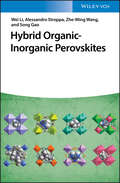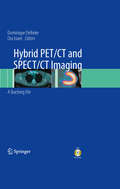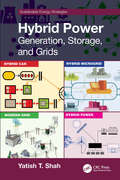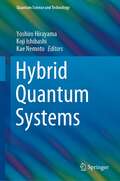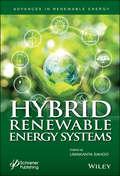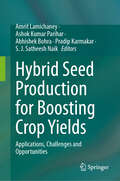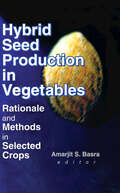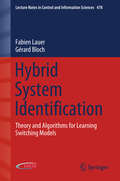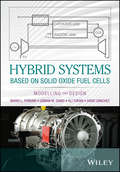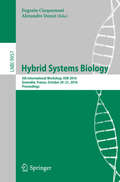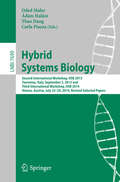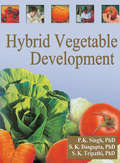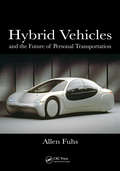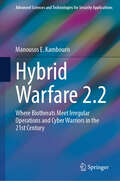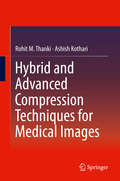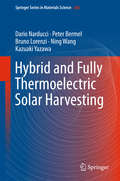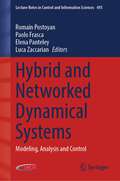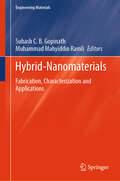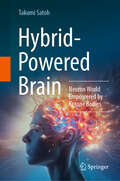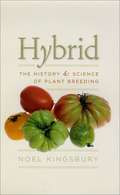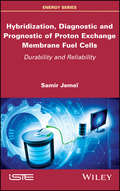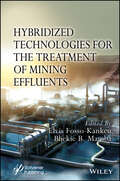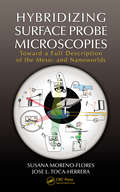- Table View
- List View
Hybrid Organic-Inorganic Perovskites
by Wei Li Song Gao Alessandro Stroppa Zhe-ming WangHybrid organic-inorganic perovskites (HOIPs) have attracted substantial interest due to their chemical variability, structural diversity and favorable physical properties the past decade. This materials class encompasses other important families such as formates, azides, dicyanamides, cyanides and dicyanometallates. The book summarizes the chemical variability and structural diversity of all known hybrid organic-inorganic perovskites subclasses including halides, azides, formates, dicyanamides, cyanides and dicyanometallates. It also presents a comprehensive account of their intriguing physical properties, including photovoltaic, optoelectronic, dielectric, magnetic, ferroelectric, ferroelastic and multiferroic properties. Moreover, the current challenges and future opportunities in this exciting field are also been discussed. This timely book shows the readers a complete landscape of hybrid organic-inorganic pervoskites and associated multifuctionalities.
Hybrid PET/CT and SPECT/CT Imaging
by Ora Israel Dominique DelbekeThis practical guide is a reference source of cases for images obtained on state-of-the-art integrated PET/CT and SPECT/CT imaging systems. It covers the full spectrum of clinical applications, including head and neck tumors, breast cancer, colorectal cancer, pancreatic cancer, and genitourinary tumors. In addition a wealth of illustrations reinforce the key teaching points discussed throughout the book.
Hybrid Power: Generation, Storage, and Grids (Sustainable Energy Strategies)
by Yatish T. ShahHybrid energy systems integrate multiple sources of power generation, storage, and transport mechanisms and can facilitate increased usage of cleaner, renewable, and more efficient energy sources. Hybrid Power: Generation, Storage, and Grids discusses hybrid energy systems from fundamentals through applications and discusses generation, storage, and grids. Highlights fundamentals and applications of hybrid energy storage Discusses use in hybrid and electric vehicles and home energy needs Discusses issues related to hybrid renewable energy systems connected to the utility grid Describes the usefulness of hybrid microgrids and various forms of off-grid energy such as mini-grids, nanogrids, and stand-alone systems Covers the use of hybrid renewable energy systems for rural electrification around the world Discusses various forms and applications of hybrid energy systems, hybrid energy storage, hybrid microgrids, and hybrid off-grid energy systems Details simulation and optimization of hybrid renewable energy systems This book is aimed at advanced students and researchers in academia, government, and industry, seeking a comprehensive overview of the basics, technologies, and applications of hybrid energy systems.
Hybrid Quantum Systems (Quantum Science and Technology)
by Yoshiro Hirayama Koji Ishibashi Kae NemotoThis book presents state-of-the-art research on quantum hybridization, manipulation, and measurement in the context of hybrid quantum systems. It covers a broad range of experimental and theoretical topics relevant to quantum hybridization, manipulation, and measurement technologies, including a magnetic field sensor based on spin qubits in diamond NV centers, coherently coupled superconductor qubits, novel coherent couplings between electron and nuclear spin, photons and phonons, and coherent coupling of atoms and photons. Each topic is concisely described by an expert at the forefront of the field, helping readers quickly catch up on the latest advances in fundamental sciences and technologies of hybrid quantum systems, while also providing an essential overview.
Hybrid Renewable Energy Systems
by Umakanta SahooThe energy scene in the world is a complex picture of a variety of energy sources being used to meet the world’s growing energy needs. There is, however, a gap in the demand and supply. It is recognized that decentralized power generation based on the various renewable energy technologies can, to some extent, help in meeting the growing energy needs. The renewable energy landscape has witnessed tremendous changes in the policy framework with accelerated and ambitious plans to increase the contribution of renewable energy such as solar, wind, bio-power, and others. Hybrid renewable energy systems are important for continuous operation and supplements each form of energy seasonally, offering several benefits over a stand-alone system. It can enhance capacity and lead to greater security of continuous electricity supply, among other applications. This book provides a platform for researchers, academics, industry professionals, consultants and designers to discover state-of-the-art developments and challenges in the field of hybrid renewable energy. Written by a team of experts and edited by one of the top researchers in hybrid renewable systems, this volume is a must-have for any engineer, scientist, or student working in this field, providing a valuable reference and guide in a quickly emerging field.
Hybrid Seed Production for Boosting Crop Yields: Applications, Challenges and Opportunities
by Abhishek Bohra Ashok Kumar Parihar Amrit Lamichaney Pradip Karmakar S. J. Satheesh NaikThis book provides an overview of various procedures involved in hybrid seed production of field and vegetable crops, including historical development and principles, maintenance of seed purity of parental lines, evolution of breeding systems, male sterility and self-incompatibility. A section of the proposed book is dedicated to quality control procedures, comprising of purity testing, seed testing and certification process, and seed production management. The major shortcomings of the existing systems, new opportunities and future prospects of hybrid seed production are also discussed. The book focuses on field and vegetable crops like rice, maize, pearl millet, sorghum, pigeon pea, rapeseed, mustard, cotton, castor, soybean, and sunflower among others. This book is for students, researchers, and professionals working in the field of public sectors and commercial seed industries, as well as to other stakeholders who are working to improve their skills on hybrid seed production.
Hybrid Seed Production in Vegetables: Rationale and Methods in Selected Crops
by Amarjit S. BasraProduce hardy, high-yield vegetables with hybrid seeds!From the Preface, by Amarjit S. Basra: “The phenomenon of heterosis, also referred to as 'hybrid vigor,’underlies much of the improvement in crop yields achieved in the twentieth century. The exploitation of heterosis in crop production is of vital importance in facing the challenge of providing food and nutritional security for an ever-increasing human population.“The effective use of heterosis has fostered the development of a worldwide seed industry. Rapid advances in plant breeding and associated seed production technologies have served to enhance the competitiveness of hybrids by increasing crop and seed yield per hectare, reducing the costs involved, and improving seed quality.”Hybrid Seed Production in Vegetables: Rationale and Methods in Selected Crops will help crop scientists and growers increase the quality and yield of vegetables such as: cucumbers cabbage pumpkins squash peppers onions gourds and the fruits watermelon and winter melon. This valuable book provides up-to-date research about heterosis, cultivars, hybrids, and molecular markers to help you get the most quality and quantity out of your seeds. Containing suggestions and methods for overcoming male plant sterility, inbreeding, and challenges to pollination, Hybrid Seed Production in Vegetables will help you successfully breed hybrid plants to produce bountiful and healthy crops.
Hybrid System Identification: Theory and Algorithms for Learning Switching Models (Lecture Notes in Control and Information Sciences #478)
by Fabien Lauer Gérard BlochHybrid System Identification helps readers to build mathematical models of dynamical systems switching between different operating modes, from their experimental observations. It provides an overview of the interaction between system identification, machine learning and pattern recognition fields in explaining and analysing hybrid system identification. It emphasises the optimization and computational complexity issues that lie at the core of the problems considered and sets them aside from standard system identification problems. The book presents practical methods that leverage this complexity, as well as a broad view of state-of-the-art machine learning methods.The authors illustrate the key technical points using examples and figures to help the reader understand the material. The book includes an in-depth discussion and computational analysis of hybrid system identification problems, moving from the basic questions of the definition of hybrid systems and system identification to methods of hybrid system identification and the estimation of switched linear/affine and piecewise affine models. The authors also give an overview of the various applications of hybrid systems, discuss the connections to other fields, and describe more advanced material on recursive, state-space and nonlinear hybrid system identification.Hybrid System Identification includes a detailed exposition of major methods, which allows researchers and practitioners to acquaint themselves rapidly with state-of-the-art tools. The book is also a sound basis for graduate and undergraduate students studying this area of control, as the presentation and form of the book provides the background and coverage necessary for a full understanding of hybrid system identification, whether the reader is initially familiar with system identification related to hybrid systems or not.
Hybrid Systems Based on Solid Oxide Fuel Cells: Modelling and Design
by Ali Turan David Sánchez Mario L. Ferrari Usman M. DamoA comprehensive guide to the modelling and design of solid oxide fuel cell hybrid power plants This book explores all technical aspects of solid oxide fuel cell (SOFC) hybrid systems and proposes solutions to a range of technical problems that can arise from component integration. Following a general introduction to the state-of-the-art in SOFC hybrid systems, the authors focus on fuel cell technology, including the components required to operate with standard fuels. Micro-gas turbine (mGT) technology for hybrid systems is discussed, with special attention given to issues related to the coupling of SOFCs with mGTs. Throughout the book emphasis is placed on dynamic issues, including control systems used to avoid risk conditions. With an eye to mitigating the high costs and risks incurred with the building and use of prototype hybrid systems, the authors demonstrate a proven, economically feasible approach to obtaining important experimental results using simplified plants that simulate both generic and detailed system-level behaviour using emulators. Computational models and experimental plants are developed to support the analysis of SOFC hybrid systems, including models appropriate for design, development and performance analysis at both component and system levels. Presents models for a range of size units, technology variations, unit coupling dynamics and start-up and shutdown behaviours Focuses on SOFCs integration with mGTs in light of key constraints and risk avoidance issues under steady-state conditions and during transient operations Identifies interaction and coupling problems within the GT/SOFC environment, including exergy analysis and optimization Demonstrates an economical approach to obtaining important experimental results while avoiding high-cost components and risk conditions Presents analytical/computational and experimental tools for the efficient design and development of hardware and software systems Hybrid Systems Based on Solid Oxide Fuel Cells: Modelling and Design is a valuable resource for researchers and practicing engineers involved in fuel cell fundamentals, design and development. It is also an excellent reference for academic researchers and advanced-level students exploring fuel cell technology.
Hybrid Systems Biology
by Eugenio Cinquemani Alexandre DonzéThis book constitutes the refereed proceedings of the 5th International Workshop on Hybrid Systems Biology, HSB 2016, held in Grenoble, France, in October 2016. The 11 full papers presented in this book were carefully reviewed and selected from 26 submissions. They were organized and presented in 4 thematic sessions also reflected in this book: model simulation; model analysis; discrete and network modelling; stochastic modelling for biological systems.
Hybrid Systems Biology
by Oded Maler Ádám Halász Thao Dang Carla PiazzaThis book constitutes the thoroughly refereedpost-workshop proceedings of the Second International Workshop on HybridSystems Biology, HSB 2013, held as part of the ECAL 2013 event, in Taormina,Italy, in September 2013; and the Third International Workshop on HybridSystems Biology, HSB 2014, held as part of CAV 2014, in Vienna, Austria, inJuly 2014. This volume presents 8 full papers together with 2invited tutorials/surveys from 21 submissions. The HSB 2013 workshop aims at collecting scientistsworking in the area of hybrid modeling applied to systems biology, in order todiscuss about current achieved goals, current challenges and future possibledevelopments. The scope of the HSB 2014 workshop is the general areaof dynamical models in biology with an emphasis on hybrid approaches, which arenot restricted to a narrow class of mathematical models, and which takeadvantage of techniques developed separately in different sub-fields.
Hybrid Vegetable Development
by Praveen K Singh Shaibal K Dasgupta Subodh K TripathiGet all the resource information you need on hybrid vegetable developmentin one book!Discover the latest concepts in breeding and development of hybrid vegetables with Hybrid Vegetable Development. Respected authorities share their views on the most recent trends and the techniques used for hybrid vegetable development in various
Hybrid Vehicles: and the Future of Personal Transportation
by Allen FuhsUncover the Technology behind Hybrids and Make an Intelligent Decision When Purchasing Your Next Vehicle With one billion cars expected to be on the roads of the world in the near future, the potential for war over oil and the negative environmental effects of emissions will be greater than ever before. Now is the time to seriously consider an alte
Hybrid Warfare 2.2: Where Biothreats Meet Irregular Operations and Cyber Warriors in the 21st Century (Advanced Sciences and Technologies for Security Applications)
by Manousos E. KambourisThe concept of Hybrid Warfare has gained prominence in recent decades. It is a novel terminology, but the concept is detectable since antiquity: Ancient Chinese, Ancient Greeks and the Jews of Exodus were all well familiar, so well to have let us know. Similarly, bioagents have been used malevolently since always. What is novel is that these two, in the present context, are not only interfacing smoothly, but in an enhanced context: The Hybrid Warfare, which has now enriched its portfolio, from actions of provocation, insurgency, economic warfare, special operations, proxy warfare and social destabilization to the Residual domain, the cyberspace, while the conventional, 3D space expands. Now the Space and the Deep are included in the topography of the friction zone. In this, the bio- factor becomes not only relevant but also an amplifier: using the technology malevolently, all the advances made to combat disease may be used to cause, further, or perplex and complicate disease. Improved or totally novel or even alien germs may replace explosives in bombs, shells or suicidal /kamimaze drones and taint bullets and fragments. Microrobots may deliver cancer cells to targeted individuals to foster cancer, or specific supergerms for an infection to rage unchallenged. And what happens if the mechanism of these cancers and infections is intentionally provided with an Abort signal? Global extortions would become probable, not just possible. Far from Science Fiction, this dystopia becomes more probable by the day. The Artificial Intelligence simply makes it easier to occur. Technology allows manipulation and intervention in levels and extends only imagined in the Past, but the application of these capabilities is clearly of dual use, with the destructive potential leveraged by the complexity of the social and state structure. Within this book, we explore the “How” (occasionally the “What” also) in some of these instances. From cyber terrorists to aggressive bioindustrialists and “democratized” ballistic and cruise missile technology, it could be coined as "The Book of Modern Mayhem”.
Hybrid and Advanced Compression Techniques for Medical Images
by Rohit M. Thanki Ashish KothariThis book introduces advanced and hybrid compression techniques specifically used for medical images. The book discusses conventional compression and compressive sensing (CS) theory based approaches that are designed and implemented using various image transforms, such as: Discrete Fourier Transform (DFT), Discrete Cosine Transform (DCT), Discrete Wavelet Transform (DWT), and Singular Value Decomposition (SVD) and greedy based recovery algorithm. The authors show how these techniques provide simulation results of various compression techniques for different types of medical images, such as MRI, CT, US, and x-ray images. Future research directions are provided for medical imaging science. The book will be a welcomed reference for engineers, clinicians, and research students working with medical image compression in the biomedical imaging field. Covers various algorithms for data compression and medical image compression;Provides simulation results of compression algorithms for different types of medical images;Provides study of compressive sensing theory for compression of medical images.
Hybrid and Fully Thermoelectric Solar Harvesting
by Ning Wang Dario Narducci Peter Bermel Bruno Lorenzi Kazuaki YazawaThis book provides a comprehensive overview on fully thermal and hybrid solar generators based on thermoelectric devices. The book fills a gap in the literature on solar conversion and thermoelectrics, because despite the growing number of papers dealing with the use of thermoelectrics in solar power conversion, no book exists for PV specialists or thermoelectricity experts to enter this field. The book is intended as a primer for scientists or engineers willing to complement their expertise in one of the two fields, and to get an updated, critical review of the state of the art in thermoelectric solar harvesting.
Hybrid and Networked Dynamical Systems: Modeling, Analysis and Control (Lecture Notes in Control and Information Sciences #493)
by Luca Zaccarian Elena Panteley Paolo Frasca Romain PostoyanHybrid and Networked Dynamical Systems treats a class of systems that is ubiquitous in everyday life. From energy grids to fleets of robots or vehicles to social networks to biological networks, the same scenario arises: dynamical units interact locally through a connection graph to achieve a global task. The book shows how analysis and design tools can be adapted for control applications that combine the effects of network-induced interactions and hybrid dynamics with complex results.Following a scene-setting introduction, the remaining 12 chapters of the book are divided into three parts and provide a unique opportunity to describe the big picture that is the culmination of years of recent research activity. The contributing authors expand on their ideas at greater length than is possible in an archival research paper and use in-depth examples to illustrate their theoretical work.The widespread importance of hybrid and networked systems means that the book is of significant interest to academic researchers working in applied mathematics, control, and electrical, mechanical and chemical engineering and to their industrial counterparts.
Hybrid-Energy Cutting of Aerospace Alloys
by Guolong Zhao Wenfeng Ding Biao Zhao Ning Qian Moran Xu Yanbin Zhang Daohui XiangThis book pioneers the exploration of hybrid-energy cutting for aerospace alloys, summarizing cutting-edge research on laser-assisted, ultrasonic vibration-assisted, electrical-assisted, and hybrid-energies-assisted cutting. It also covers enhanced heat transfer in cutting processes, proposing novel technologies for achieving geometric precision and surface integrity at low costs. The book delves into multi-energy fields interaction mechanisms, material removal, tool wear, and cutting performance of aerospace alloys, alongside green and high-efficient cooling technologies. Targeting researchers, scientists, engineers, and professionals in aerospace, materials science, mechanical engineering, and manufacturing, this advanced-level resource assumes a solid background in engineering and materials science. It provides detailed discussions on theoretical aspects and practical applications of hybrid-energy cutting techniques. This book is a valuable reference for advanced researchers and practitioners in aerospace alloys cutting. It provides a comprehensive exploration of hybrid-energy technologies, detailed insights into mechanisms and performance, and a focus on sustainable and cost-effective cutting solutions.
Hybrid-Nanomaterials: Fabrication, Characterization and Applications (Engineering Materials)
by Subash C. B. Gopinath Muhammad Mahyiddin RamliThis book highlights the importance of surface nanomaterials for analytical applications and diagnostics. As widely been stated, surface is the base for all downstream analytical applications and the incorporation of additional material to form a hybrid makes a drastic improvement in the performance of the surfaces. Even though, metallic hybrid materials play a pivotal role, non-metallic and metallic hybrid materials yield new avenues. Characterization of these hybrid nanomaterials provides a detailed insight, which attests to new inventions and novel materials. Hybrid nanomaterials are characterized by analytical systems and to generate the analytical systems hybrid materials are essential. The potential of hybrid nanomaterials exists within various interdisciplinary sciences including medicine, which this book presents.
Hybrid-Powered Brain: Neuron World Empowered by Ketone Bodies
by Takumi SatohThis book unlocks the secrets of a powerful and sustainable brain, as well as explores the concept of a hybrid-powered brain and the transformative potential of the "Small Ketogenic" system.Supplying the brain with an ample energy substrate is vital for a positive mindset and a fulfilling day. Adequate energy fuels sharp thinking and clear judgement, while an energy-deficient brain leads to a variety of problems. Low blood glucose levels make it difficult to remember and amplify negative emotions. Delve into the brain's often-overlooked energy system to avoid these situations.The human brain functions on two energy systems: glucose from carbohydrates and ketone bodies from fats. These systems complement each other, and activating the hybrid system is surprisingly simple. Adopting the "Small Ketogenic" means extending the intervals between meals and allowing for a slight feeling of hunger within a reasonable range. This approach preserves cognitive function to the maximum.Inspired by the longevity of individuals in certain villages, the hybrid-powered brain enhances mental vitality. These villagers lead vibrant lives fuelled by their powerful minds. Maintaining ketone body concentrations between 0.2-0.5 mM ensures an active and calm brain. By making slight adjustments in eating habits, and adopting the "Small Ketogenic", we can achieve healthy longevity. This sustainable approach boosts the brain and promotes optimal health effects.Embark on a transformative journey of self-improvement and discover the true potential of your brain. This book revolutionises the way you perceive and care for your brain, leading you to a sustainable and fulfilling cognitive existence.
Hybrid: The History and Science of Plant Breeding
by Noel KingsburyDisheartened by the shrink-wrapped, Styrofoam-packed state of contemporary supermarket fruits and vegetables, many shoppers hark back to a more innocent time, to visions of succulent red tomatoes plucked straight from the vine, gleaming orange carrots pulled from loamy brown soil, swirling heads of green lettuce basking in the sun. With Hybrid, Noel Kingsbury reveals that even those imaginary perfect foods are themselves far from anything that could properly be called natural; rather, they represent the end of a millennia-long history of selective breeding and hybridization. Starting his story at the birth of agriculture, Kingsbury traces the history of human attempts to make plants more reliable, productive, and nutritious--a story that owes as much to accident and error as to innovation and experiment. Drawing on historical and scientific accounts, as well as a rich trove of anecdotes, Kingsbury shows how scientists, amateur breeders, and countless anonymous farmers and gardeners slowly caused the evolutionary pressures of nature to be supplanted by those of human needs--and thus led us from sparse wild grasses to succulent corn cobs, and from mealy, white wild carrots to the juicy vegetables we enjoy today. At the same time, Kingsbury reminds us that contemporary controversies over the Green Revolution and genetically modified crops are not new; plant breeding has always had a political dimension. A powerful reminder of the complicated and ever-evolving relationship between humans and the natural world, Hybrid will give readers a thoughtful new perspective on--and a renewed appreciation of--the cereal crops, vegetables, fruits, and flowers that are central to our way of life.
Hybriden: bei Bäumen und Sträuchern
by Dietrich BöhlmannKreuzungen zwischen verschiedenen Arten gibt es nicht nur im Tierreich (wie Maultier, Maulesel), sondern auch in hohem Maβe bei den Holzgewachsen. Lange wurden die Hybriden aus den gangigen Geholzfuhrern ausgeklammert, obwohl sie so essentiell fur die Forstwirtschaft und den Gartenbau sind. Auf diesem Gebiet ist das Buch das einzige Werk, das die Erkennungsmerkmale aller 137 Hybridenarten sowie ihrer Eltern tabellarisch auflistet und vergleichend gegenuberstellt. Daher ist eine exakte Bestimmung, auch mithilfe des ausfuhrlichen Bildmaterials, garantiert. Jede Hybride wird in ihrer botanischen und forstwirtschaftlichen Bedeutung in einem begleitenden Text beschrieben. Tabellen mit charakteristischen Merkmalen erganzen die durchgehend farbigen Fotos von Blattern und Fruchten. Seinen aktuellen Bezug erhalt dieses Ubersichts- und Bestimmungsbuch durch die einzigartige Auflistung und Darstellung aller Hybriden und ihrer Eltern. Es schließt eine wichtige Lucke in der gartenbaulichen und forstlichen Literatur, sodass es nicht nur zur Bestimmung, sondern auch zur Auswahl und Nutzung der Hybriden fur Aufgaben in der Land- und Forstwirtschaft zu Rate gezogen werden kann. Unverzichtbar fur jeden Botaniker, Forstwissenschaftler, Pflanzenzuchter und Studenten der Forstwissenschaft.
Hybridization, Diagnostic and Prognostic of PEM Fuel Cells: Durability and Reliability
by Samir JemeiHydrogen is the most abundant element in the universe. It has a place in the energy mix of the future, especially regarding fuel cells (FCs). This book is an investigation into FCs. Prominence is given to the subject of PEMFCs (proton exchange membrane fuel cells) as they offer interesting perspectives on transport and stationary applications. This being said, a number of technological and scientific obstacles remain to be overcome before an industrial level of development can be reached.
Hybridized Technologies for the Treatment of Mining Effluents
by Elvis Fosso-Kankeu Bhekie B. MambaHYBRIDIZIED TECHNOLOGIES FOR THE TREATMENT OF MINING EFFLUENTS The main goal of this book is to review the principles, development, and performances of hybridized technologies that have been used for the treatment of mine effluents. Recent developments consist of the integration/hybridization of technologies to achieve the effective removal of pollutants from acid mine drainage (AMD) effluents in a stepwise manner such as to ensure that the cost of the process is minimized, and the resulting water is fit for purpose. This book presents eight specialized chapters that provide a state-of-the-art review of the different hybridized technologies that have been developed over the years for the treatment of mine effluent, including AMD. The successful implementation and challenges of these technologies are highlighted to give the reader a perspective on the management of such waste in the mining industry. In this innovative book, readers will be introduced to The limitations of passive and active treatment processes as stand-alone technologies while appraising the functioning and performances of these technologies when combined to address their challenges; The numerous approaches that have been considered over the years for effective combination of these technologies are explored taking into account their successful implementation at large scale as well as the long-term sustainability. Audience This book will be of interest to academic researchers from the fields of environment, chemistry, engineering, mineral processing, hydrometallurgy, geochemistry, and professionals including mining plant operators, environmental managers in the industries, water treatment plants managers and operators, water authorities, government regulatory bodies officers and environmentalists.
Hybridizing Surface Probe Microscopies: Toward a Full Description of the Meso- and Nanoworlds
by Susana Moreno-Flores Jose L. Toca-HerreraMany books and reviews about scanning probe microscopies (SPM) cover the basics of their performance, novel developments, and state-of-the-art applications. Taking a different approach, Hybridizing Surface Probe Microscopies: Towards a Full Description of the Meso- and Nanoworlds encompasses the technical efforts in combining SPM with spectroscopic and optical complementary techniques that, altogether, provide a complete description of nanoscale and mesoscale systems and processes from corrosion to enzymatic reactions. The book is organized into eight chapters, following a general scheme that revolves around the two main capabilities of SPM: imaging and measuring interactions. Each chapter introduces key theoretical concepts and basic equations of the particular stand-alone technique with which the scanning probe microscopies are combined. Chapters end with the SPM-technique combination and some real-world examples in which the combination has been devised or used. Most chapters include a historical review of the techniques and numerous illustrations to support key ideas and provide the reader with intuitive understanding. To understand the limitations of any technique also means to understand how this technique works. This book has devoted a considerable amount of space in explaining the basics of each technique as they are being introduced. At the same time, it avoids explaining the particularities of each SPM-based technique and opts for a rather generalized approach. In short, the book’s focus is not on what SPM can do, but rather on what SPM cannot do and, most specifically, on presenting the experimental approaches that circumvent these limitations.
